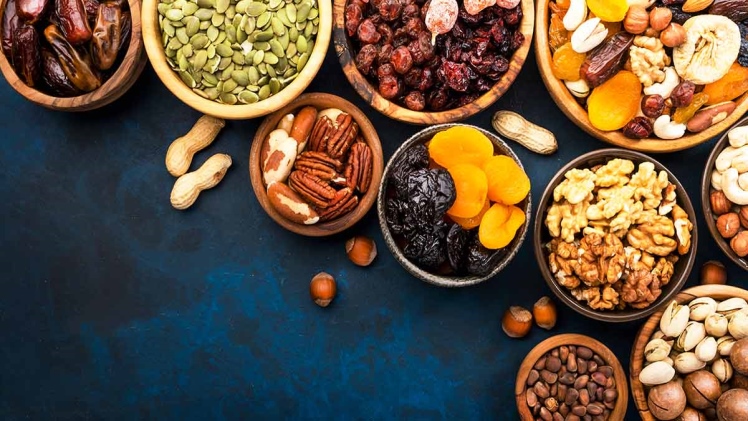Dried fruits are nature’s candy, a delightful blend of natural sweetness and concentrated flavors. They are created by removing the moisture from fresh fruits, extending their shelf life and making them convenient, portable snacks. In this article, we will explore six popular dried fruits, each offering a unique taste and a range of health benefits.
Section 1: The Drying Process
Before diving into specific dried fruit varieties, it’s essential to understand the drying process. Drying fruit involves removing most of the water content while preserving its natural sugars, vitamins, and minerals. This process extends the fruit’s shelf life and intensifies its flavor. Common methods of drying include sun drying, air drying, and dehydration using specialized equipment.
Section 2: The Health Benefits of Dried Fruits
Dried fruits are nutrient-dense snacks that offer several health benefits:
2.1. Rich in Nutrients: Dried fruits contain essential vitamins and minerals, such as vitamin C, potassium, and dietary fiber.
2.2. Natural Sweetness: They provide a natural source of sweetness, making them a healthier alternative to refined sugars.
2.3. Convenience: Dried fruits are portable, making them ideal for on-the-go snacking, hiking, and travel.
2.4. Nutritional Density: They offer a concentrated source of nutrients due to the removal of water content.
Section 3: 6 Popular Dried Fruits
Now, let’s explore six popular dried fruit varieties, each with its own distinct flavor profile and nutritional benefits:
3.1. Raisins:
Flavor: Raisins are dried grapes and have a sweet and slightly tangy flavor.
Nutritional Highlights: They are a good source of potassium, iron, and antioxidants like resveratrol.
Usage: Raisins are versatile and can be eaten as a snack, added to oatmeal, yogurt, or baked into bread and cookies.
3.2. Apricots:
Flavor: Dried apricots have a naturally sweet and mildly tangy taste.
Nutritional Highlights: They are rich in vitamin A, vitamin C, potassium, and dietary fiber.
Usage: Enjoy dried apricots as a healthy snack, chop them up in salads, or incorporate them into baked goods.
3.3. Dates:
Flavor: Dates are known for their intensely sweet and caramel-like flavor.
Nutritional Highlights: They are an excellent source of energy, providing natural sugars, fiber, potassium, and magnesium.
Usage: Dates can be eaten on their own, used as natural sweeteners in smoothies, or stuffed with nuts for a wholesome snack.
3.4. Figs:
Flavor: Dried figs have a unique, honey-like sweetness with a slightly nutty undertone.
Nutritional Highlights: They are rich in dietary fiber, calcium, potassium, and antioxidants.
Usage: Enjoy dried figs as a snack, pair them with cheese, or incorporate them into both sweet and savory dishes.
3.5. Prunes (Dried Plums):
Flavor: Prunes are known for their sweet, plummy taste with a hint of tartness.
Nutritional Highlights: They are well-regarded for their digestive benefits due to their high fiber content. Prunes are also a good source of vitamin K and potassium.
Usage: Prunes are often enjoyed as a digestive aid, added to oatmeal, or used in baking.
3.6. Cranberries:
Flavor: Dried cranberries are known for their sweet and tangy flavor.
Nutritional Highlights: They are a good source of vitamin C, vitamin E, dietary fiber, and antioxidants.
Usage: Dried cranberries are popular in trail mixes, salads, and baked goods. They are also a common addition to breakfast cereals and yogurt.
Section 4: Creative Ways to Enjoy Dried Fruits
Dried fruits are not only delicious on their own but also versatile ingredients that can enhance a variety of dishes:
4.1. Trail Mix: Create your own custom trail mix by combining your favorite dried fruits with nuts, seeds, and a touch of chocolate or yogurt-covered raisins.
4.2. Baked Goods: Add dried fruits to muffins, cookies, bread, and granola bars for extra flavor and natural sweetness.
4.3. Salads: Sprinkle dried fruits like cranberries, apricots, or figs onto salads to add a sweet and chewy contrast to fresh greens and vegetables.
4.4. Breakfast: Stir dried fruits into your morning oatmeal, yogurt, or cereal to elevate your breakfast experience.
4.5. Meat Dishes: Dried fruits like apricots, figs, and dates can be paired with poultry or roasted meats to create sweet and savory flavor combinations.
Section 5: Storage Tips
To maintain the quality and shelf life of dried fruits, follow these storage guidelines:
5.1. Airtight Containers: Store dried fruits in airtight containers or resealable bags to prevent moisture absorption and maintain freshness.
5.2. Cool and Dry: Keep your dried fruits in a cool, dry place, away from direct sunlight and humidity.
5.3. Refrigeration: While not always necessary, refrigerating dried fruits can extend their shelf life further, especially in warmer climates.
5.4. Freeze for Long-Term Storage: For even longer storage, consider freeze dried strawberries in airtight containers or vacuum-sealed bags.
Section 6: Conclusion
Dried fruits are not only delicious but also nutritious and versatile ingredients that can enhance a wide range of dishes. From raisins to apricots, dates to figs, and prunes to cranberries, each variety brings its unique flavors and nutritional benefits to the table. Whether enjoyed as a snack, incorporated into recipes, or used to add natural sweetness to your meals, dried fruits are a delightful addition to a healthy diet. Just remember to store them properly to maintain their freshness and flavor for extended periods.


